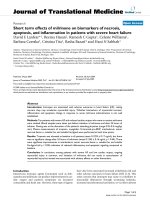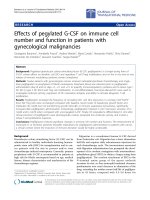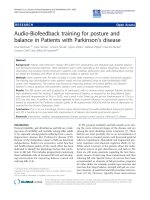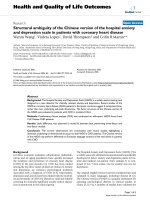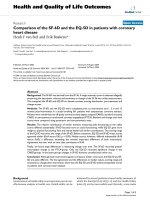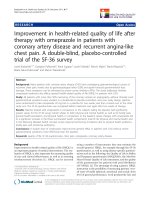antiplatelet response to aspirin and clopidogrel in patients with coronary artery disease undergoing percutaneous coronary intervention
Bạn đang xem bản rút gọn của tài liệu. Xem và tải ngay bản đầy đủ của tài liệu tại đây (5.13 MB, 252 trang )
Glasgow Theses Service
Good, Richard I.S. (2014) Antiplatelet response to aspirin and
clopidogrel in patients with coronary artery disease undergoing
percutaneous coronary intervention. MD thesis.
Copyright and moral rights for this thesis are retained by the author
A copy can be downloaded for personal non-commercial research or
study, without prior permission or charge
This thesis cannot be reproduced or quoted extensively from without first
obtaining permission in writing from the Author
The content must not be changed in any way or sold commercially in any
format or medium without the formal permission of the Author
When referring to this work, full bibliographic details including the
author, title, awarding institution and date of the thesis must be given
Antiplatelet Response to Aspirin and Clopidogrel in
Patients with Coronary Artery Disease Undergoing
Percutaneous Coronary Intervention
by
Dr Richard I.S. Good
B.A., M.B.B.S., M.R.C.P
A thesis submitted in fulfillment of the requirements
for the Degree of Doctor of Medicine
College of Medical, Veterinary and Life Sciences
University of Glasgow
June 2013
Page | 2
Abstract
Aspirin and clopidogrel are cornerstone therapies in cardiovascular disease. In particular, they
are almost universally prescribed in patients undergoing percutaneous coronary intervention
(PCI). Evidence has emerged of a variation in the antiplatelet effects of aspirin and clopidogrel
between individual patients with a suggestion of an increased risk of adverse cardiovascular
events. However, the optimal method of measuring response to aspirin and clopidogrel
remains uncertain. In light of this, the antiplatelet effects of both aspirin and clopidogrel were
studied in patients with coronary artery disease, concentrating on patients undergoing PCI.
Initially, a pilot study of 40 patients investigated the use of thromboxane B2 (TxB2),
VerifyNow Aspirin, VerifyNow P2Y12, platelet fibrinogen binding and intra-platelet
vasodilator-stimulated phosphoprotein levels (VASP-PRI) to measure response to aspirin and
clopidogrel. This was followed by a larger study assessing aspirin and clopidogrel response in
323 patients attending for coronary angiography with a view to PCI. These patients were
tested by measuring TxB2, VerifyNow P2Y12, VASP and whole blood impedance platelet
aggregation (WBPA). The primary objective was to investigate whether measures of aspirin or
clopidogrel efficacy predicted peri-procedural myocardial necrosis following PCI. In addition,
a small series of 10 patients had aspirin and clopidogrel response measured following stent
thrombosis.
A wide variation in the antiplatelet effects of both aspirin and clopidogrel was found by all
measures. Correlation between assays ranged from moderate to poor. Of particular interest, it
was found that measurement of [TxB2] may facilitate the assessment of aspirin response in
patients already taking clopidogrel. There was a high incidence of myocardial necrosis
following coronary intervention assessed by elevation of troponin I. Only VerifyNow P2Y12
and VASP-PRI were associated with a significantly increased frequency of myocardial
necrosis following PCI.
The data of this thesis confirm a wide variation in response to aspirin and clopidogrel. Good
response to clopidogrel was associated with reduced myocardial necrosis during PCI. TxB2
may be the best measure of aspirin response for patients taking both therapies. How these
measures may be incorporated into clinical practice remains uncertain.
Page | 3
Contents
Abstract 2
List of Figures 10
List of Tables 13
List of abbreviations 15
Acknowledgements 19
Author’s declaration 20
Chapter 1: Variation in response to aspirin 21
1.1 Aspirin in cardiovascular disease 21
1.1.1 Introduction 21
1.1.2 The evolution of aspirin for the treatment of cardiovascular disease 21
1.1.3 Dosage of aspirin in cardiovascular disease 24
1.1.4 Aspirin in percutaneous coronary intervention 25
1.2 Variation in response to aspirin 26
1.2.1 Aspirin ‘resistance’ 26
1.3 Assays for assessing response to aspirin 28
1.3.1 Challenges of assessing platelet function 28
1.3.2 (Optical) Light Transmission Aggregometry (LTA) 29
1.3.3 Whole Blood Impedance Platelet Aggregometry (WBPA) 31
1.3.4 Measurement of thromboxane metabolites 32
1.3.5 Platelet flow cytometry 35
1.3.6 Rapid platelet function analyser (RPFA), VerifyNow Aspirin 36
1.3.7 Platelet function analyser (PFA-100) 38
1.3.8 Thromboelastography (TEG) 39
1.3.9 Other assays to assess aspirin response 40
Page | 4
1.4 Comparison of methods to assess the response to aspirin 40
1.5 Aspirin response and clinical outcomes 42
1.5.1 Measuring response to aspirin in patients taking dual antiplatelet therapy 44
1.6 Aetiology of variation in response to aspirin 45
1.7 Conclusion 47
Chapter 2: Variation in response to clopidogrel 48
2.1 Clopidogrel in cardiovascular disease 48
2.1.1 Introduction 48
2.1.2 The evolution of clopidogrel for the treatment cardiovascular disease 49
2.1.3 Dosage of clopidogrel in cardiovascular disease 55
2.2 Variation in response to clopidogrel 58
2.2.1 Clinical outcomes associated with variable response to clopidogrel 60
2.2.2 Aetiology of variable response to clopidogrel 63
2.3 Assays to assess response to clopidogrel 66
2.3.1 Optical light transmission aggregometry 66
2.3.2 Platelet flow cytometry 67
2.3.3 Whole Blood Impedance Aggregometry 72
2.3.4 Rapid Platelet Function Analyser, VerifyNow P2Y12 73
2.3.5 Platelet Function Analyser-100 74
2.3.6 Thromboelastography 74
2.4 Comparison of assays to assess response to clopidogrel 75
2.5 Conclusion 79
2.6 Aims 80
Page | 5
Chapter 3: Materials and Methods 82
3.1 Patient selection and recruitment 82
3.1.1 Exclusion criteria 82
3.2 Blood sample collection for platelet assays 83
3.3 Platelet assays methods 84
3.3.1 Ultegra RFPA – VerifyNow Aspirin, VerifyNow P2Y12 84
3.3.2 Thromboxane B2 in serum and plasma 84
3.3.3 Whole Blood Platelet Aggregation 86
3.3.4 Optical Light Transmission Aggregometry 88
3.3.5 Flow cytometric evaluation of platelet function 88
3.3.6 Measurement of platelet fibrinogen binding by flow cytometry 90
3.3.7 Measurement of intraplatelet VASP-phosphorylation by flow cytometry 93
3.4 Additional blood sample collection 96
3.5 Coronary angiography and percutaneous coronary intervention 96
3.6 Troponin measurement pre and post percutaneous coronary intervention 96
3.7 Funding of the research 97
3.8 Conduct and monitoring of the research 97
3.9 Statistical methods 97
Chapter 4: Variation in the antiplatelet effects of aspirin assessed by
measurements of thromboxane, whole blood platelet aggregation and VerifyNow
Aspirin 98
Study 4.1: Variation in thromboxane B2 in serum and plasma in patients taking regular low
dose aspirin with and without clopidogrel therapy 100
4.1.1 Introduction 100
4.1.2 Patient selection 100
4.1.3 Sample acquisition and processing 102
Page | 6
4.1.4 Statistical methods 102
4.1.5 Results 103
4.1.6 Discussion 114
Study 4.2: Variation in thromboxane concentration and whole blood platelet aggregation in
patients taking aspirin and clopidogrel 117
4.2.1 Introduction 117
4.2.2 Patient selection 118
4.2.3 Sample acquisition and processing 118
4.2.4 Statistical methods 119
4.2.5 Results 119
4.2.6 Discussion 127
Study 4.3: VerifyNow Aspirin for the assessment of the antiplatelet effects of aspirin 131
4.3.1 Introduction 131
Study 4.3.1: Investigation of the use of VerifyNow Aspirin to differentiate aspirinated vs
non-aspirinated patients 131
Study 4.3.2: Comparison of VerifyNow Aspirin using cationic propyl gallate and
arachidonic acid as agonists 133
Study 4.3.3: The effects of clopidogrel on aspirin response measured by VerifyNow
Aspirin 134
4.4 Conclusion 137
Chapter 5: Assessing response to clopidogrel in patients with coronary artery
disease 138
Study 5.1 VerifyNow P2Y12, fibrinogen activation and VASP-phosphorylation before and
after the introduction of clopidogrel 139
5.1.1 Introduction 139
5.1.2 Patient selection 140
Page | 7
5.1.3 Sample collection and processing 140
5.1.4 Statistical Methods 141
5.1.5 Results 143
5.1.6 Discussion 145
Study 5.2: Response to clopidogrel assessed by VASP-Phosphorylation , VerifyNow P2Y12
and Whole Blood Platelet Aggregation in patients with coronary artery disease 147
5.2.1 Introduction 147
5.2.2 Patient selection 147
5.2.3 Sample acquisition and processing 148
5.2.4 Statistical methods 148
5.2.5 Results 149
5.2.6 Discussion 164
5.3 Conclusion 169
5.3.1 Limitations of Studies 5.1 and 5.2 171
Chapter 6: Aspirin and clopidogrel response and the incidence of myocardial
necrosis following percutaneous coronary intervention 173
Study 6.1: Correlation between measures of aspirin and clopidogrel response in patients
attending for coronary angiography with a view to PCI 173
6.1.1 Introduction 173
6.1.2 Patient selection 174
6.1.3 Sample acquisition and processing 176
6.1.4 Statistical methods 176
6.1.5 Results 176
6.1.6 Discussion 181
Study 6.2: Aspirin and clopidogrel response and peri-procedural myocardial necrosis
following PCI 184
Page | 8
6.2.1 Introduction 184
6.2.2 Patient selection 184
6.2.3 Platelet function assays and measurement of cardiac enzymes 184
6.2.4 Statistical methods 185
6.2.5 Results 185
6.2.6 Discussion 192
6.3 Conclusion 196
Chapter 7: Response to aspirin and clopidogrel in patients suffering stent
thrombosis 197
7.1 Introduction 197
7.2 Patient selection 198
7.3 Sample collection and processing 198
7.4 Statistical methods 199
7.5 Results 199
7.6 Discussion and conclusion 203
Chapter 8: Thesis conclusion 205
8.1 Future directions of research 207
Appendix I: Patient information sheet for pilot study 209
Appendix II: Consent form for pilot study 214
Appendix III: Patient information sheet for main research project 216
Appendix IV: Consent form for main research project 221
Appendix V: Patient information sheet for stent thrombosis study 223
Appendix VI: Consent form for stent thrombosis study 227
Page | 9
References 229
Publications containing work undertaken for this thesis 250
Presentations to Learned Societies of work undertaken for this thesis 250
Page | 10
List of Figures
Figure 1: The principle of Born-type platelet aggregation 30
Figure 2: Principles of whole blood impedance platelet aggregometry 31
Figure 3: The secretion and metabolism of thromboxane in humans 33
Figure 4: Complex interaction of agonists and pathways involved in platelet activation and
aggregation 35
Figure 5: Rapid platelet function analyser (Accumetrics, USA) and VerifyNow Aspirin
cartridge 36
Figure 6: Principles underlying the VerifyNow cartridge to assess platelet aggregation in
whole blood 37
Figure 7: Platelet function analyser, PFA-100 (Siemens Healthcare Diagnostics) 38
Figure 8: Principles of thromboelastography 39
Figure 9: Comparison of light transmission aggregometry (LTA) to arachidonic acid and
VerifyNow Aspirin (CPG) for the assessment of platelet inhibition by aspirin 41
Figure 10: Poor correlation between LTA in response to arachidonic acid and PFA-100 CEPI
for the assessment of response to aspirin 43
Figure 11: Mechanisms of action of the platelet P2Y receptors 50
Figure 12: Inhibition of ADP induced platelet aggregation in patients included in the
PRONTO study 56
Figure 13: Frequency distribution of response to clopidogrel assessed by LTA to ADP 60
Figure 14: The interaction of PGE1, ADP and P2Y12 inhibitors (thienopyridines) on VASP
phosphorylation 69
Figure 15: The central role of VASP-phosphorylation in the pathways activated by stimulation
of the platelet P2Y
12
receptor. 70
Figure 16: Stability of VASP-PRI for 24-48 hours following sample acquisition 72
Figure 17: Correlation coefficient for 6 assays used to evaluate response to clopidogrel 78
Page | 11
Figure 18: Chronolog whole blood platelet aggregometer and disposable electrode 86
Figure 19: Output from the Aggro/Link Interface of WBPA in response to ADP 20mmol
(Trace 1) and collagen 2µl (Trace 2) 87
Figure 20: The principle components of a 3 channel flow cytometer 89
Figure 21: Typical output from the BD FACSCalibre flow cytometer for a patient immediately
prior to coronary intervention established on clopidogrel therapy 92
Figure 22: Typical output of VASP assay tube T1 containing PGE1 alone. 94
Figure 23: Typical output of VASP assay tube T2 containing PGE1 and ADP. 95
Figure 24: Flow diagram illustrating the design of study 4.1 101
Figure 25: Pre clopidogrel [TxB2] 107
Figure 26: Correlation of log
10
[TxB2]
S-P
and VerifyNow Aspirin assays. 109
Figure 27: Paired samples of thromboxane B2 before and after the introduction of clopidogrel
110
Figure 28: Spearman's rho correlation coefficients between [TxB2] before and after the
introduction of clopidogrel 112
Figure 29: Change in [TxB2]
S-P
following the introduction of clopidogrel vs clopidogrel
response 113
Figure 30: Illustrative distribution column plot for concentration of TxB2 including median
and IQR. 122
Figure 31: Frequency distribution of [TxB2]
S-P
on a logarithmic scale. 123
Figure 32: Frequency distribution of change in impedance induced by Collagen 2µl. 125
Figure 33: Correlation between WBPA in response to 2µl collagen and log
10
[TxB2]
S-P
127
Figure 34: Assessment of aspirinated vs non-aspirinated subjects using VerifyNow Aspirin
cationic propyl gallate assay 132
Figure 35: Ultegra RPFA cationic propyl gallate(CPG) vs arachidonic acid(AA) assay
cartridges 134
Figure 36: Ultegra RPFA, VerifyNow Aspirin before and after clopidogrel treatment 135
Page | 12
Figure 37: Correlation between fibrinogen binding and VASP-PRI for all assays (baseline,
pre-PCI and post-PCI) 145
Figure 38: VASP-PRI results for patients from study 5.2 145
Figure 39: Change in platelet function assays following the introduction of clopidogrel 152
Figure 40: Frequency distribution of clopidogrel response assays (a) VASP-P PRI (b)
VerifyNow P2Y12 (c) WBPA-ADP. 155
Figure 41: Correlation between change in VerifyNow P2Y12 %inhibition following the
introduction of clopidogrel and absolute VerifyNow P2Y12 %inhibition. 156
Figure 42: Pre vs Post-clopidogrel response measured by VerifyNow P2Y12. 157
Figure 43: Correlations between the three assays used to measure clopidogrel response. 159
Figure 44: Bland-Altman plot of VerifyNow P2Y12 %inhibition and (100-VASP-PRI). 160
Figure 45: VASP-PRI in diabetic and non-diabetic patients, demonstrating a significant
difference in response to clopidogrel between these two groups 161
Figure 46: VerifyNow P2Y12 %inhibition according to whether the patient was taking a
proton pump inhibitor in conjunction with dual antiplatelet therapy. 162
Figure 47: Flow chart summarising patient recruitment and sampling for the main research
project. 175
Figure 48: Correlation of [TxB2]
S-P
and clopidogrel response assessd by; (a) VerifyNow
P2Y12 and (b) VASP-PRI. 178
Figure 49: Correlation between WBPA-Col 2 and VerifyNow P2Y12 %inhibition. 179
Figure 50: Frequency distribution of log10 transformed Troponin elevation following PCI . 189
Figure 51: Frequency of troponin I elevation following PCI for each quartile of platelet
function assay results. 191
Figure 52: Number of days from stent implantation to stent thrombosis. 201
Page | 13
List of Tables
Table 1: Studies comparing assays to assess response to clopidogrel published before the
initiation of this research. 76
Table 2: Studies published since 2006 evaluating clopidogrel response using multiple assays77
Table 3: Patient characteristics for study 4.1. 104
Table 4: Summary statistics of [TxB2] in plasma and serum before and after clopidogrel
therapy and VerifyNow Aspirin. 105
Table 5: Multiple regression model of Pre Clopidogrel [TxB2]
S-P
and patient characteristics
108
Table 6: Patient characteristics for Study 4.2 including significant predictors of each platelet
function assay according to a multiple regression analysis 120
Table 7: Summary statistics of TxB2 concentrations and WBPA in response to collagen and
TRAP. 121
Table 8: A comparison of [TxB2] in plasma and serum in samples acquired by venepuncture
or by aspiration from an arterial sheath prior to coronary angiography. 124
Table 9: Correlation coefficients between WBPA assays and [TxB2] 125
Table 10: Independent sample t-test comparing WBPA assay results between samples
acquired from the arterial sheath and by venepuncture. 126
Table 11: The demographics of patients included in Study 5.1 142
Table 12: Variation in clopidogrel response before clopidogrel, before PCI and after PCI
assessed using 3 different assays 143
Table 13: Correlation coefficients between the assays used to measure clopidogrel response
144
Table 14: Characteristics of patients recruited to Study 5.2 with the results of the multiple
regression model investigating the influence on platelet function testing 150
Table 15: ADP based platelet function assays before and after clopidogrel therapy 151
Page | 14
Table 16: Independent t-test comparing distribution of clopidogrel response between samples
collected by venepuncture and those from the arterial sheath. 160
Table 17: ANCOVA test to investigate variation in response according to the three different
loading regimens of clopidogrel 163
Table 18: Pearson's correlation coefficients between assays assessing response to aspirin and
clopidogrel 177
Table 19: Mode of presentation of patients recruited to Studies 4.2, 5.2, 6.1 and 6.2 179
Table 20: Comparison of pre-clopidogrel platelet function assay results between patients
presenting acutely and those with a stable presentation. 180
Table 21: Comparison of platelet function assay results on DAPT between patients presenting
acutely and those with a stable presentation. 181
Table 22: Patient characteristics for participants that underwent coronary intervention and
those managed medically 186
Table 23: Procedural details for patients that underwent coronary intervention. 187
Table 24: Platelet function assay results for patients undergoing PCI 188
Table 25: Chi-square test comparing troponin elevation between the upper and lower quartiles
of each platelet function test. 190
Table 26: Patient characteristics of stent thrombosis patients compared to our larger data set of
patients tested for aspirin and clopidogrel response. 200
Table 27: Comparison of platelet function assays for patients suffering stent thrombosis. 202
Page | 15
List of abbreviations
AA
arachidonic acid
ACEI
angiotensin converting enzyme inhibitor
ACS
acute coronary syndrome
ADP
adenosine diphosphate
AG
Professor Alison Goodall
AHA
American Heart Association
AM
Anne McGarrity
ARB
angiotensin receptor blocker
ARU
aspirin reaction units
ALBION
Assessment of the best Loading dose of clopidogrel to Blunt platelet
activation, Inflammation and Ongoing Necrosis
ANCOVA
analysis of covariance
ARC
Academic Research Consortium
ARMYDA-2
Antiplatelet therapy for Reduction of MYocardial Damage during
Angioplasty
ATTC
Antiplatelet Trialists’ Collaboration
BD
Beckton Dickinson
BMI
body mass index
BMS
bare metal stent
BRAVE-3
Bavarian Reperfusion Alternatives Evaluation-3
CABG
Coronary Artery Bypass Grafting
CAPRIE
Clopidogrel versus Aspirin in Patients at Risk of Ischaemic Events
CATS
Canadian American Ticlopidine Study
CCB
calcium channel blocker
CHARISMA
Clopidogrel for High Atherothrombotic Risk and Ischemic
Stabilization, Management, and Avoidance
CLARITY-TIMI 28
Clopidogrel as Adjunctive Reperfusion Therapy–Thrombolysis in
Myocardial Infarction
CLASSICS
Clopidogrel Aspirin Stent International Cooperative Study
CK-MB
creatinine kinase - MB
COMMIT
Clopidogrel and Metoprolol in Myocardial Infarction
Page | 16
COX
cyclo-oxygenase
CPG
cationic propyl gallate
CREDO
Clopidogrel for the Reduction of Events During Observation
CURE
Clopidogrel in Unstable angina to prevent Recurrent Events
CVA
cerebrovascular accident
CV
coefficient of variation
Cx
circumflex
CYP
cytochrome P459
DAPT
dual antiplatelet therapy
DES
drug eluting stent
ECG
electrocardiogram
EDTA
Ethylenediaminetetraacetic acid
ELISA
enzyme-linked immune sorbent assay
EQC
Electronic Quality Control
ESC
European Society of Cardiology
FANTASTIC
Full anticoagulation versus ASpirin and TIClopidine after stent
implantation
FITC
fluorescein isothiocyanate
FS
forward scatter
GPIIbIIIa
glycoprotein IIbIIIa
GRAVITAS
Gauging Responsiveness with A VerifyNow assay - Impact on
Thrombosis And Safety
GUSTO
Global Utilization of Streptokinase and Tissue Plasminogen
Activator for Occluded Arteries
HBS
HEPES buffered saline
HM
Helen Miller
HRP
horseradish peroxidase
HOPE
Heart Outcomes Prevention Evaluation
ISAR
Intracoronary Stenting and Antithrombotic Regimen
ISAR CHOICE
Intracoronary Stenting and Antithrombotic Regimen: Choose
Between 3 High Oral Doses for Immediate Clopidogrel Effect
Page | 17
ISAR-REACT
Intracoronary Stenting and Antithrombotic Regimen- Rapid Early
Action for Coronary Treatment
ISIS-2
Second International Study of Infarct Survival -2
ISR
in-stent restenosis
IVUS
intravascular ultrasound
LAD
left anterior descending
LIMA
left internal mammary artery
LMWT
low molecular weight
LMS
left main stem
LTA
light transmission aggregometry
MA
maximum clot strength (TEG)
MACE
major adverse cardiovascular event
MATTIS
Multicenter Aspirin and Ticlopidine Trial after Intracoronary
Stenting
MFI
mean fluorescence intensity
MI
myocardial infarction
NHS
National Health Service
NSTEMI
non-ST elevation myocardial infarction
OM
obtuse marginal
PAR
protease-activated receptors
PCI
percutaneous coronary intervention
PFA
platelet function analyser
PGH2
prostaglandin H2
PLATO
PLatelet Inhibition and Patient Outcomes study
POBA
plain old balloon angioplasty
POPULAR
Do Platelet Function Assays Predict Clinical Outcomes in
Clopidogrel-Pretreated Patients Undergoing Elective PCI?
PPACK
D-phenylalanyl-prolyl-arginine chloromethyl ketone
PPI
proton pump inhibitor
PRONTO
Plavix Reduction Of New Thrombus Occurrence
R
reaction time (TEG)
RCA
right coronary artery
Page | 18
RFPA
rapid platelet function analyser
RG
Richard Good
SAT
sub-acute stent thrombosis
SD
standard deviation
SS
side scatter
ST
stent thrombosis
STARS
STent Anticoagulation Restenosis Study
STEMI
ST-elevation myocardial infarction
SVG
saphenous vein graft
SYNTAX
SYNergy Between PCI With TAXus and cardiac surgery
TASS
Ticlopidine Aspirin Stroke Study
TDS
ter die sumendum
TEG
thromboelastography
TIA
transient ischaemic attack
TIMI
Thrombolysis In Myocardial Infarction
TJ
Tina James
TxA2
thromboxane A2
TxB2
thromboxane B2
ULN
upper limit of normal
VASP-PRI
Vasodilator-stimulated phosphoprotein – platelet reactivity index
WBPA
whole blood impedance platelet aggregometry
11DTxB2
11-dehydro thromboxane B2
Page | 19
Acknowledgements
I would like to thank my principal supervisors, Professor Keith Oldroyd and Professor Alison
Goodall, for their advice, support, patience and encouragement throughout the design and
execution of this research including the completion of this thesis. I would also like to thank Dr
Alex McConnachie in the Robertson Centre for Biostatistics for his guidance with the
statistical power calculations and data analysis.
I am extremely grateful to my friends and colleagues at the Western Infirmary and elsewhere
for their help and assistance with this research. Support has come from many different sources
to help with patient recruitment, blood sampling at the time of cardiac catheterisation and the
challenges of collecting and analysing data from a large series of patients. There are too many
people to thank individually but I would particularly like to thank Anne McGarrity and Helen
Miller for their dedication in undertaking the majority of platelet function assays that form the
core of this work.
I am very grateful to the British Heart Foundation, the North Glasgow University Hospitals
NHS Trust West Research Endowment Fund, the Graham Wilson Travel Scholarship and
Merck, Sharpe and Dohme US Medical School Grant Committe for their generosity in
providing support for this project.
Most importantly, I would like to thank the patients who agreed to participate in this research
project. I am humbled by the willingness they have shown to discuss and consent to
participation in this research despite the considerable anxiety that exists at the time of invasive
investigations and treatment.
Finally I would like to thank my family, and particularly my wife and boys, for their sacrifice
in helping me to complete this work. This thesis is dedicated to them.
Page | 20
Author’s declaration
I declare that, except where explicit reference is made to the contribution of others, this
dissertation is the result of my own work and has not been submitted for any other degree at
the University of Glasgow or any other institution.
Richard Good
June 2013
Page | 21
Chapter 1: Variation in response to aspirin
1.1 Aspirin in cardiovascular disease
1.1.1 Introduction
Aspirin is the most widely prescribed and regularly consumed medication in the world.
Approximately one third of the adult population of North America is thought to be taking
regular aspirin, amounting to billions of tablets consumed every year. However, despite such
common acceptance, much controversy remains. The role in primary and long term secondary
prevention has been questioned, aspirin continues to cause significant side effects, the optimal
dose is uncertain and newer antithrombotic agents, that may prove superior to aspirin,
continue to emerge.
In this chapter, I initially review the salient stages in aspirin’s evolution, the evidence to
support its use and recent controversies regarding widespread aspirin prescription for the
prevention of cardiovascular disease. I also describe the evidence to support aspirin as a
cornerstone therapy for patients undergoing coronary intervention. Leading on from this, I
review the emergence of ‘aspirin resistance’ or poor response to aspirin, the assays used to
measure aspirin response and whether these measures can predict clinical outcome.
1.1.2 The evolution of aspirin for the treatment of cardiovascular disease
The medicinal use of compounds containing salicylate derivatives has been documented for
more than 3000 years (1). Notes from the mid-eighteenth century confirm the use of willow
bark extract – known to be rich in salicylates – for its beneficial effects on pain, inflammation
and fever. Towards the end of the 19
th
century, the chemical structure of acetylsalicylic acid
was established and in 1897 it was marketed by the pharmaceutical company Bayer under the
trade name Aspirin (2). Bayer lost the rights to the trademark aspirin during the First World
War, but aspirin continued to grow in popularity particularly during the 1918 flu pandemic (1).
Page | 22
With such widespread usage, it became apparent that acetyl salicylic acid had additional blood
thinning properties, initially thought to be an anticoagulant effect via interaction with the
coagulation cascade. In 1948 a letter to The Lancet suggested that this may be of benefit in the
treatment of thrombotic disease including coronary thrombosis and in 1949 two cases of
unstable angina rapidly relieved by the administration of aspirin were reported (3,4). Perhaps
the most persuasive early insights into the blood thinning properties of aspirin came from the
little recognised physician L.L. Craven. He reported in 1950 the interesting observation that,
since the introduction of aspirin gum for the relief of pain, he had experienced a significant
number of post-procedural bleeds following tonsillectomy (5). Remarkably for that time, he
then made the intellectual leap to suggest aspirin for the prevention of myocardial infarction
(6).
In the late 1960s, the antithrombotic properties of aspirin were attributed to an inhibitory
effect on platelet function (7). At the same time the interaction between coronary
atherosclerosis, thrombosis and acute myocardial infarction was becoming increasingly
apparent (8). In addition, there was also emerging evidence to suggest aspirin may have a
beneficial effect in patients suffering from cerebrovascular thrombotic events (9). The natural
extension of these advances was to re-examine the anecdotal evidence that aspirin may
prevent cardiovascular events in at risk patients in the form of a clinical trial.
The first study to investigate the role of aspirin in cardiovascular disease was carried out
between 1971 and 1973 (10). This landmark randomised, double blind, placebo controlled
study investigated whether aspirin 300mg/day reduced mortality in 1239 patients following
myocardial infarction. Although there was a reduction in mortality in the aspirin group, the
primary endpoint did not reach statistical significance. Interestingly, the mean time from
myocardial infarction to entry to the study was 9.8 weeks and on further subgroup analysis,
differences in mortality were only seen in those patients recruited within 6 weeks of their
index event. Subsequently, a raft of studies was published in patients with a history of stroke,
TIA, myocardial infarction and unstable angina. Although individually these studies were
often too small to yield statistically significant mortality and morbidity benefits, pooled
analysis published in 1988 suggested a highly significant reduction in death, non-fatal MI and
non-fatal stroke in those patients taking aspirin (11).
Page | 23
Following the somewhat mixed results of individual studies looking at the long term reduction
of events in patients with documented history of previous myocardial infarction or unstable
angina, and in light of prior suggestion of particular benefit to patients early in the post
myocardial infarction period, the Second International Study of Infarct Survival (ISIS-2) was
designed to investigate the benefits of aspirin in the setting of an evolving ST-elevation
myocardial infarction (12). ISIS-2 randomised over 17000 patients, within 24 hours of the
onset of symptoms of suspected MI, in a 2x2 factorial design, to receive placebo, aspirin,
streptokinase or a combination of the two agents. Aspirin was prescribed as 160mg/day for 1
month and showed a significant reduction in death, reinfarction and stroke either alone or in
combination with streptokinase. This early mega-study cemented the routine use of aspirin in
patients experiencing a myocardial infarction.
The 2002 Antithrombotic Trialist’s Collaboration (ATTC) meta-analysis illustrates the
difficult task of assimilating the available data in this field into comprehensive
recommendations (13). Although only considering trials published before 1998 and excluding
studies smaller than 200 patients, 197 studies were included in the analysis. As a further
complication, the indications for aspirin prescription include stable angina, coronary bypass
grafting, coronary angioplasty, heart failure, atrial fibrillation, cardiac valve disease and
surgery, peripheral vascular disease, haemodialysis, diabetes mellitus, and asymptomatic
carotid disease. From this data, the group concluded that, in patients at high risk of
cardiovascular events or those with known cardiovascular disease, regular aspirin reduces the
risk of death, myocardial infarction and stoke by around 23%. For those patients without a
history of thromboembolic disease the recommendations were less clear due to the trade-off
between reduction in cardiovascular events and a higher incidence of bleeding.
The most recent guideline published in 2009 has attempted to address some of these
difficulties by returning to the individual participant data from trials that had recruited at least
1000 participants randomised to aspirin or placebo and followed for at least 2 years (14).
These more stringent criteria restricted the trials included to 6 primary prevention and 16
secondary prevention studies. The conclusion remained the same; a recommendation of aspirin
for the secondary prevention of cardiovascular disease but a questionable role in primary
prevention. In spite of this, there remains a degree of concern regarding the validity of longer
term aspirin use and questions remain regarding the optimal dose (15).
Page | 24
1.1.3 Dosage of aspirin in cardiovascular disease
The first tablet form of aspirin marketed by Bayer in 1900 was approximately 325mg.
Arbitrarily, a children’s dose of ¼ this amount (approximately 81mg) was subsequently
produced in 1922 (1). Early studies investigating the use of aspirin following myocardial
infarction or cerebrovascular events used significantly higher doses of aspirin than would be
employed in this setting today. This is reflected in the ATTC publication from 2002 where
34/65 studies used doses between 500mg and 1500mg per day. In this same analysis, 15/65
studies used aspirin doses of 150mg or less as would be commonly prescribed today (13). This
is a reflection of the initial introduction of aspirin as an anti-inflammatory agent and even in
today’s practice doses as high as 4000mg/day may be used for this indication. However, over
the last 30 years there has been a trend towards lower maintenance doses of aspirin for the
prevention of cardiovascular disease. Considerable global variation remains. Centres in North
America routinely prescribe 325mg/day. In contrast, European centres most commonly use
doses between 75mg and 150mg per day.
Pharmacodynamic evidence suggests that a loading dose of 300mg aspirin achieves maximal
early platelet inhibition with no incremental antiplatelet effect at higher doses (16). The
celerity of this effect can be maximised by using an oral solution with peak plasma
concentrations occurring 30 minutes from ingestion (17). The irreversible nature of aspirin’s
interaction with cyclooxygenase 1 (COX-1) means that chronic doses as low as 30mg/day
have been shown to completely suppress thromboxane production in healthy volunteers (18).
However, there is evidence that thromboxane production is persistently elevated in patients
with cardiovascular disease and at least 50mg/day may be required (19).
The shift towards lower doses of aspirin for the long term treatment of cardiovascular disease
has been driven by concerns regarding bleeding side effects. It has been shown that 30mg/day
of aspirin reduces gastric prostaglandin levels by approximately 50% but complete inhibition
is only achieved at doses higher than 1300mg/day (20). This finding is reflected in clinical
data confirming a significantly higher incidence of bleeding in patients taking higher doses of
aspirin (21). Thus, later studies of aspirin use in cardiovascular and cerebrovascular disease
looked to evaluate whether an optimal dose of aspirin could be established to maximise the
antithrombotic benefits whilst minimising any adverse events (22,23). From this data and
